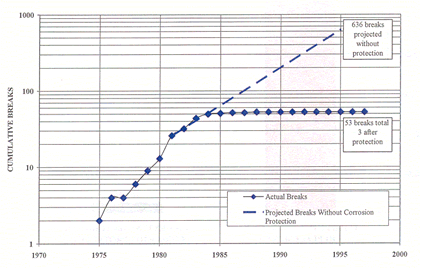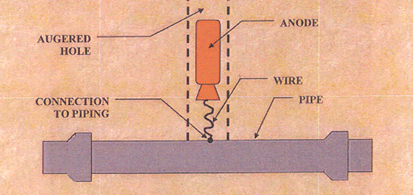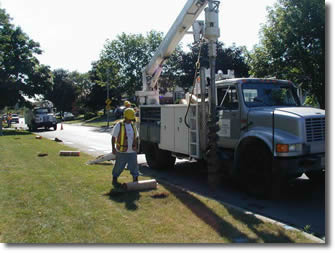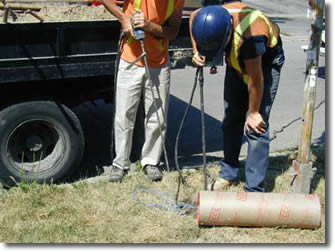The Solution to Destructive Water Main Breaks
Protecting underground pipes from leakage and bursting by a technology known as "cathodic protection" is practiced by industry and commerce worldwide. Despite this, cathodic protection has yet to be introduced to most municipalities in the United States. It has been shown to reduce 95% of potential water main leaks and breaks. It protects communities from the expense, destruction, and embarrassment caused by these unpredictable events.
Cathodic protection consists of attaching anodes (typically, a 50 lbs. magnesium rod) with a wire to "old" water mains at "hot spots" where corrosion is most aggressive. It has been promoted by the American Water Works Association (AWWA) and is popular in large cities such as New York City, as well as farm communities in Monroe County New York, and even in a small community such as Ogdensburg, New York. Figure 1 below shows data illustrating that within a year of anode installation in the Region of Durham, a bedroom community of Toronto, 53 water main breaks that had been budgeted to be repaired in 1982, were reduced to merely 3, a 95% savings.

Figure 1: Cumulative number
of breaks before and after anode
installation,
Durham Region, Ontario, Canada
Anode installation is conducted with surgical precision (see Figure 2 below). It is a 4-step method:
- Drill a 1-foot diameter hole with an auger to almost reach the pipe.
- Vacuum out the rest of the dirt; reach the pipe.
- Attach the anode to the pipe with an insulated copper wire.
- Fill the hole with dirt; repave as needed.

Figure 2: Anode installed to protect ductile and cast iron pipe
The cost, an average of $5,100 per 1000 feet of pipe, is well worth the expense and will protect you from an even greater expense later on. The anode is designed to protect the pipe for 20 years.
The cathodic protection program of the Region of Durham, Ontario, Water Department illustrates the benefits of a municipal cathodic protection program. The Durham program commenced in 1983. In the 26 years of its life, a total of $5.2 million was spent to install more than 18,000 anodes to protect more than 130 miles of ductile and cast iron mains. The estimated cost of replacing the old water mains with polyethylene or PVC was more than $172 million.
The two photos below show details of Durham's cathodic protection program.

In the photo above, there are two trucks in the background. Men in the far truck backfill and remedy the excavation site to its original condition. The truck in the middle carries anodes with welding equipment needed to attach the anodes to the water main. The truck in the foreground augers the anode holes.

This photo shows the method for attaching the anode to the water main. The anode inside its container in the cardboard tube is about 10 inches in diameter and weighs 30 lbs. The anode has a lead wire that is about 10 feet long. The end of the wire is brazed remotely to the water main 6-10 feet below the surface.
In one day, a trained crew can install 35-50 anodes for approximately 700 to 1000 feet of pipe. The cost, including engineering, is about $350 per anode. This is equivalent to about $17.50 per foot of a 20-foot long ductile iron pipe. Replacement cost of the same 20-foot long pipe is over $3,000 in a no-traffic suburbia zone. In a city center, with emergency repairs, the cost can be more than $20,000.
Comprehensive information about this program can be found in the Region of Durham Works Department Cathodic Protection Program (1983-2007) 2007 Annual Report (PDF format). Courtesy of: Dale R. Clemens, Water Department, Region of Durham, Ontario, Canada.
References
Figure 1: Technical Support Works Department Region of Durham, Ontario. "Report, the Status of the Cathodic Protection Program to Minimize the Effects of Corrosion of Exiting Ductile Iron Water Mains, Etc." January 1998.
Figure 2: Lindemuth D. and and Young W.T. "Break Reduction/Life Extension Program for Cast and Ductile Iron Water Mains." Corrpro Technical Library Paper No. 111. Available at www.corrpro.com.